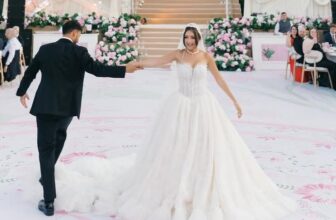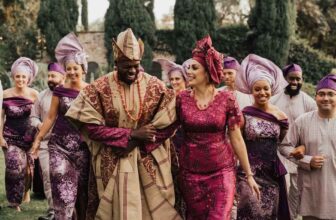Weddings in Africa cannot happen without a massive ceremony and there’s no ‘I do’ without a specific dress code. The ceremony is significant to different tribes or ethnic groups and their customs. Traditional wedding attires are a great representation of the culture of the bride and groom. There’s usually a story or a belief behind the attires and the way the couples wear them.
Ahead, we are exploring some of Africa’s most beautiful traditional wedding attires and their significance to the wedding.
1. Habesha Kemis, Ethiopian Traditional Wedding Attire
If you say you’ve been to a massive wedding and an Ethiopian wedding is not on that list then you may have to rethink. Ethiopians give new meaning to the word ‘big wedding’ with their huge wedding culture.
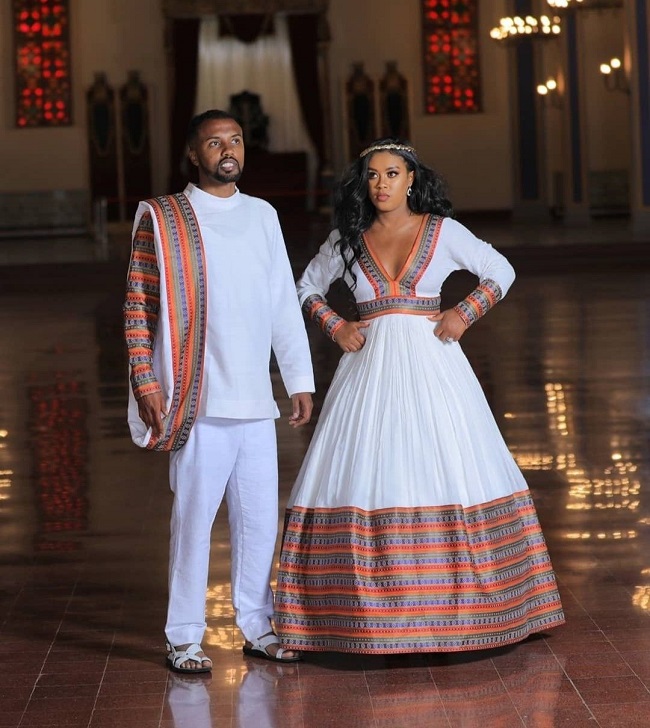 Photo: Pinterest
Photo: Pinterest According to Ethiopians, weddings are a once-in-a-lifetime opportunity so they make the most of it. An Ethiopian wedding cannot be complete without a Habesha Kemis.
The attire is made of hand-woven cotton, it is pieced together by joining the strips of hand-woven cotton together to form a beautiful dress. The dress is then hand-embroidered, making
The Habesha Kemis is the official traditional wedding attire for Ethiopians. Women wear the Habesha Kemis and adorn themselves with the Habesha jewelry while the men wear the Buffalaa-Uffannaa Gaa’elaa. The attire is made of hand-woven cotton, it is pieced together by joining the strips of hand-woven cotton together to form a beautiful dress. The dress is then hand-embroidered, making patterns known as Tibeb. The embroidery is done using materials that are shiny on the waist, leg, neck, and hand.
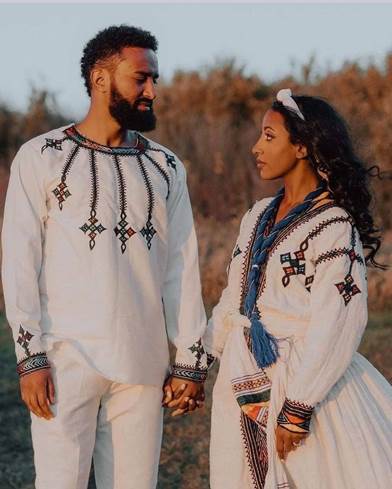 Pinterest
Pinterest The more the Tibeb on your Habesha is detailed, the more it shows that you’re wealthy or marrying into a wealthy home. The embroidery is also a testament to where the bride is coming from. The grooms can also choose to have a less dramatic attire that includes only their traditional Ethiopian outfit.
The outfit is finished with a Netela or a Kuta which is a shawl wrapped around it. The shawl is usually embroidered with the same design as the one on the bride’s Habesha.
2. Aso Oke, Nigerian Traditional Wedding Attire
Nigeria is rich with culture on every side, as a country with over 250 ethnic groups, the traditional wedding attire differs. Each attire is significant to the tribe of the bride, so the couple’s first traditional wedding attire depends on the bride’s tribe. After the traditional rites have been carried out, the bride changes into the traditional wedding attire of the groom’s tribe. This is for when both couples are from different ethnic groups.
If both couples are the same tribe, a change of traditional attire to that of another tribe will not be necessary.
In Nigeria, let’s focus on Yoruba traditional wedding attires and their significance. The Yoruba tribe in Nigeria adorns their intending couples with a two-piece attire made from Aso Oke. In the Yoruba culture, this traditional wedding attire signifies that the bride is about to start a new life.
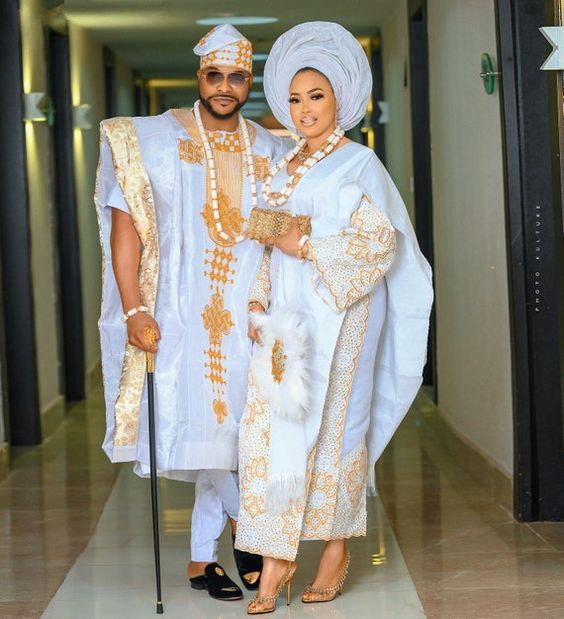 Photo Courtesy
Photo Courtesy The overall outfit consists of Gele and Iro ati Buba. Buba is a tailor-made top and Iro is a large material tied around the waist of the bride. The color of the traditional attire signifies that both families have agreed on something.
The groom wears an Agbada, a traditional Yoruba 4-piece attire. Both the bride and the groom complement each other with their attires using a color that both families have agreed to behind closed doors.
Most Nigerian traditional wedding attires seek to portray the bride as a queen and the groom as a king going to start their new home.
3. Zulu Traditional Wedding Attire, South Africa
South Africans are also loud wedding lovers. As the largest ethnic group in the country, the traditional Zulu wedding is called Umabo. It is at the Umabo that dowry (a small token given to the family of the bride) is paid. It is during the Umabo that the bride wears traditional wedding attire.
 Photo: Pinterest
Photo: Pinterest The attire consists of the Isidwaba — a short leather skirt and the Isicwaya — a strip of animal skin to cover the bride’s breast. The attire is complete with an Inkheli, a traditional hat used to cover the head. To tie the attire together, colorful beads are used by the bride and her bridesmaids.
 Photo: Pinterest
Photo: Pinterest The groom is clad in Ibheshu, a little covering made from cows’ skin he wears in place of pants and a traditional headband. The headband signifies that he has become the head of a home. If the husband chooses to wear pants, he would wear an Umbhulaselo which is a ceremonial beaded pant.
4. Ashanti Traditional Wedding Attire, Ghana
Ghanaians also love a big wedding ceremony and to make a statement, couples start off the traditional wedding ceremony clad in normal attire. A ritual called Kookoo ko is carried out where the groom goes to the bride’s house to propose with his family.
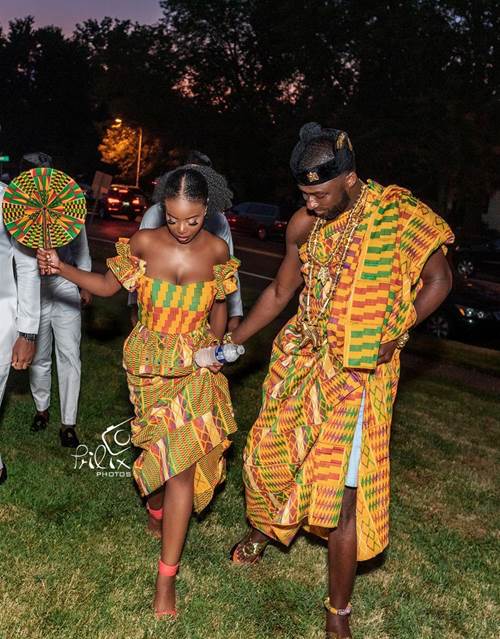 Photo: Pinterest
Photo: Pinterest Once the Kookoo ko is concluded the marriage ceremony kickstarts. At this point, the bride and the groom wear the Ghanian signature fabric called Kente. The groom wraps it around his shoulder while the bride makes a dress with it.
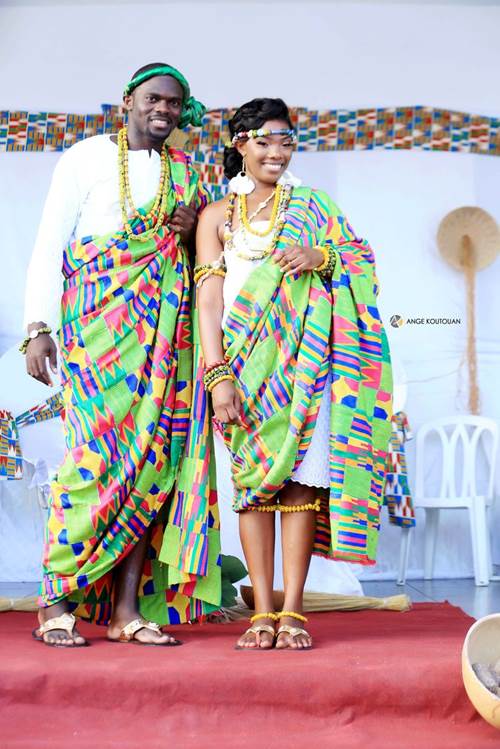 Photo: Pinterest
Photo: Pinterest The bride is adorned with beads from head to toe, so she looks like royalty, the essence is that she is now a gift her family is now handing over to her husband’s family.
5. Kikuyu Traditional Wedding Attire, Kenya
Kenyan traditional weddings are called Kikuyu, it is recognized as the official marriage. Regardless of whether the couples decide to do a white wedding party, once the Kikuyu happens, then the marriage is official. The Kikuyu involves Ruracio; payment of the bride’s dowry by the man. The bride and the groom wrap themselves with Lessos, a Kenyan traditional material.
 Photo Courtesy
Photo Courtesy The Lessos worn for weddings are brown and gold in color and they are beautified with beads all over to set them apart. The men wear animal skin with their Lessos, to signify strength, this shows that they can protect the new bride and the home.
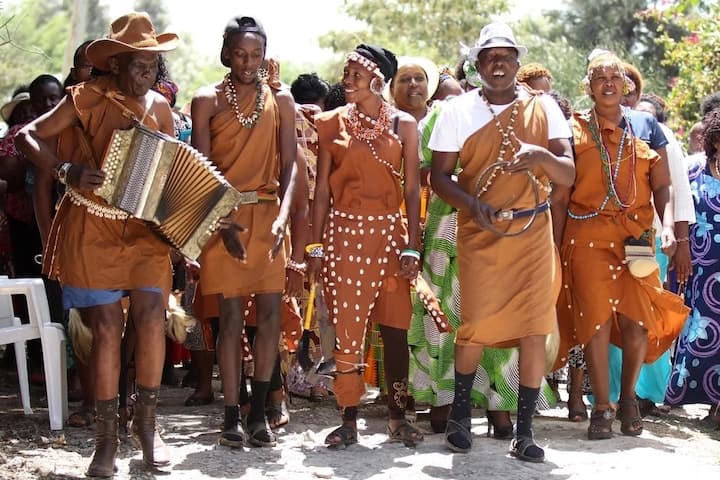 Photo: Tuko.co.ke
Photo: Tuko.co.ke The bride usually has a train of over 20 women dressed in Lesso to escort her to her new home. This is how to start the marriage on a blessed note.
6. Zimbabwean Traditional Wedding Attire
Zimbabweans have a very strong wedding culture that involves a lot of processes, the most important being the Idzila. The Idzila is a traditional neck ring made of brass and copper which the husband gifts the wife on the wedding day.
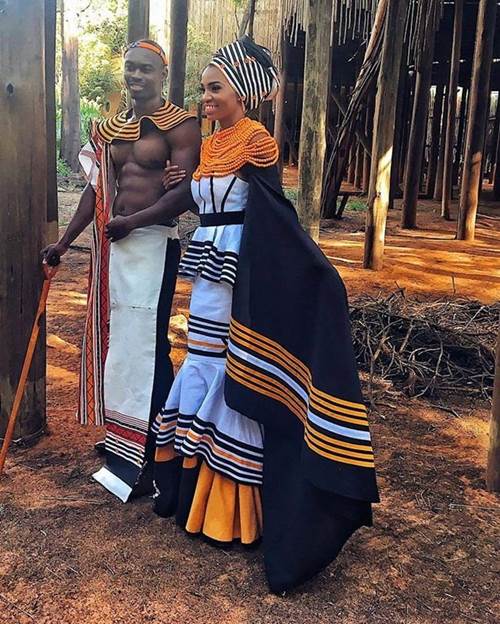 Photo Courtesy
Photo Courtesy The Idzila is said to have great powers that protect the wife. The quality of the Idzila worn by the bride on the wedding day shows how wealthy the husband is. The traditional wedding attire is called the Shona. The Shona is worn for any significant occasion in Zimbabwe including weddings.
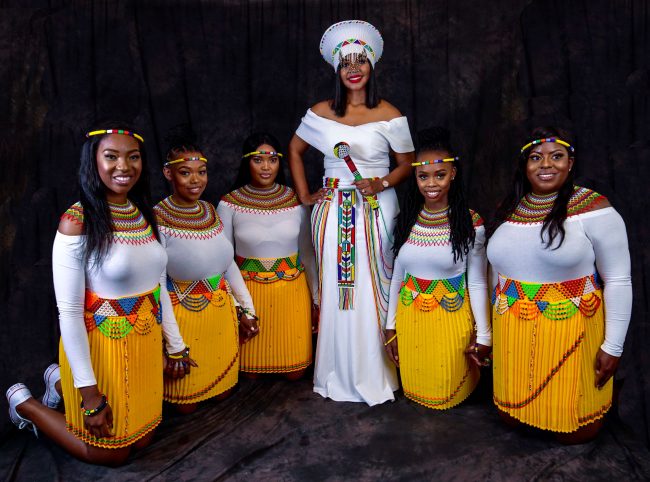 Photo: Bontlebride.com
Photo: Bontlebride.com After wearing the Shona, the bride is adorned on her neck, arms, and legs with the Idzila which is usually a gift from the husband. The man’s attire is called Buffalaa-Uffannaa Gaa elaa, a popular wedding attire in the country.
7. Chitenge Traditional Wedding Attire, Zambia
Zambian weddings are not on the loud side but it integrates a lot of cultures. There’s a long list of traditions Zambians follow before they tie the knot. The first on the list is the Lobola, which is the dowry paid to the family of the bride.
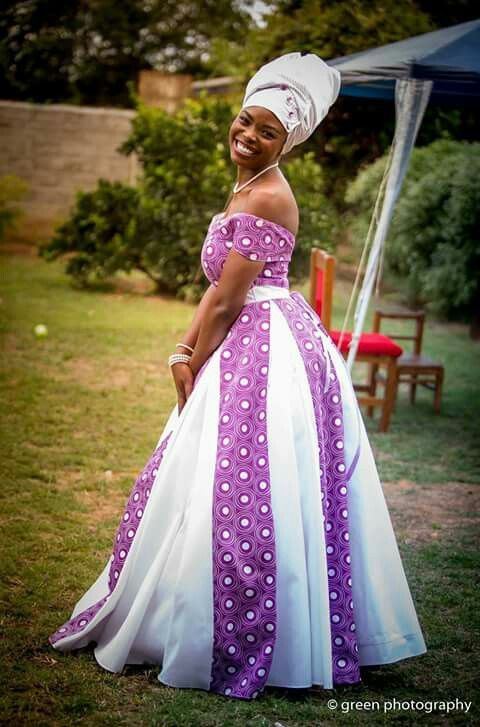 Photo: Pinterest
Photo: Pinterest In Zambia, the dowry is paid to compensate the girl’s family for the loss of her services as a girl child. Usually, the groom is meant to work for the girl’s family before he is accepted, but he can use the money to cover for it.
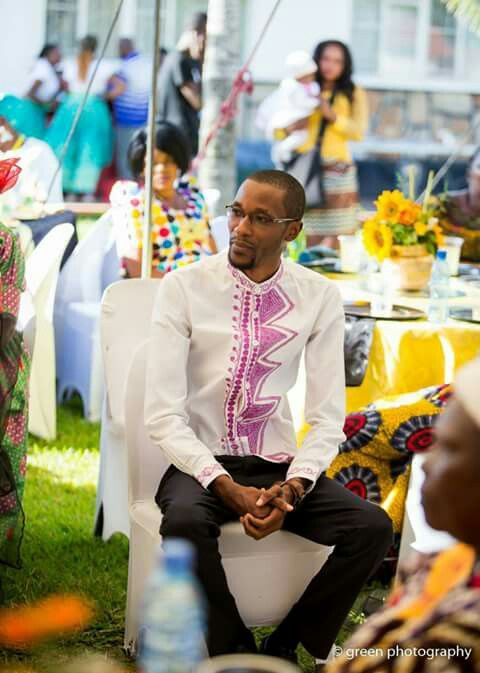 Photo: Pinterest
Photo: Pinterest After the Lobola, and the Ukukonkola, the last marriage rite, the wedding can take place properly. The bride and the groom dress up in Chitenge, which is a Zambian traditional attire. For weddings, the Chitenge seals both families together and makes them one clan.
8. Senegalese Traditional Wedding
Senegalese traditional attire is very popular all over Africa, it exudes class and wealth when made the original way. During traditional weddings, couples wear the Boubou, Senegalese clothing made from cotton and colored with bright dyes. It’s usually crafted out with a distinctive embroidery done to set the bride apart and tell the groom he has a gift.
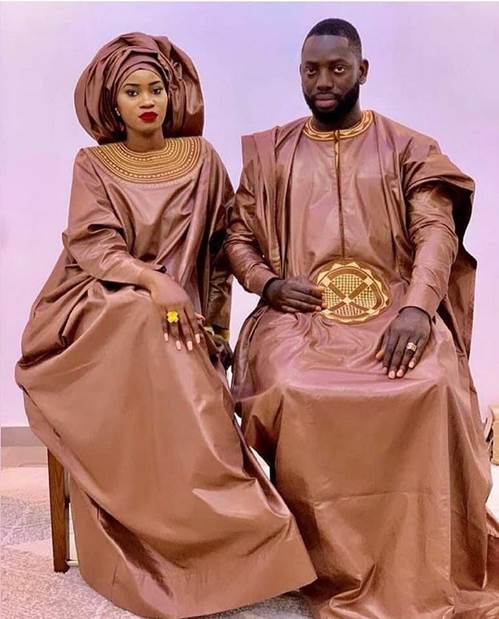 Photo courtesy
Photo courtesy The Boubou is tailored to be wide in size and according to the Senegalese tradition, only the perfect wife can fill up the Boubou with her curves.
The groom, on the other hand, is dressed in a Kaftan that depicts a prince going to get his princess. The embroidery on the man’s kaftan and the one on that of the woman must be the same.
9. Busuuti, Ugandan Traditional Wedding Attire
Ugandan couples have very ceremonial outfits for traditional weddings. The traditional wedding attire for Uganda is called the Busuuti or Gomesi. It is a colorful dress with very puffy sleeves and a large belt tied around the waist.
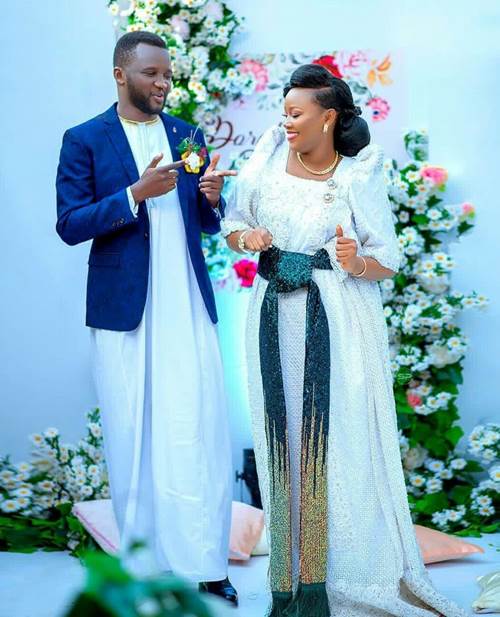 Photo: Pinterest
Photo: Pinterest The dress is usually floor length and made from either silk, linen, or cotton. The bride and groom can change their outfit as much as 3-4 times during the wedding, this and the type of material used all goes to show how wealthy the family will be after they tie the knot.
10. Egyptian Traditional Wedding Attire
Egyptian couples dress up in two wedding traditional wedding attires. One of which is all gold in color and the other one is all white. The bride wears a traditional Egyptian crown and gold pieces of jewelry on her arm, legs, and neck while the groom wraps the material around his shoulders.
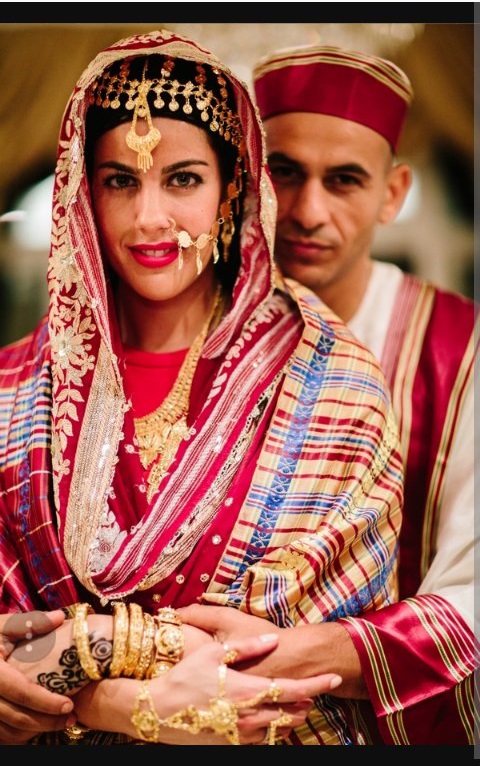 Photo courtesy
Photo courtesy The entire traditional attire for the bride and groom is golden to signify wealth and royalty. Egyptians believe that brides should exude wealth and be the pride of their husbands. The white attire signifies purity, a pure woman that hasn’t been given to anyone else before.
The white attire is worn before the traditional rites are finished. When the dowry has been paid, the couples switch to gold attire.



